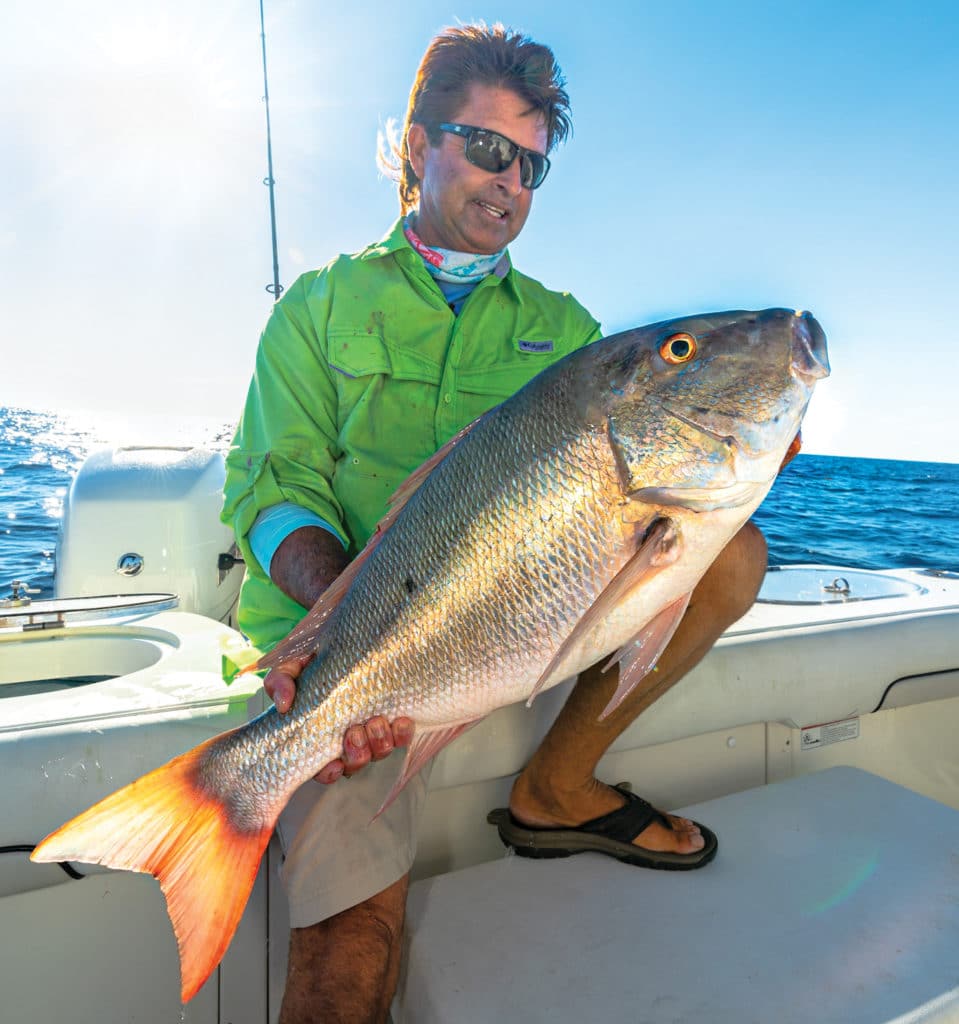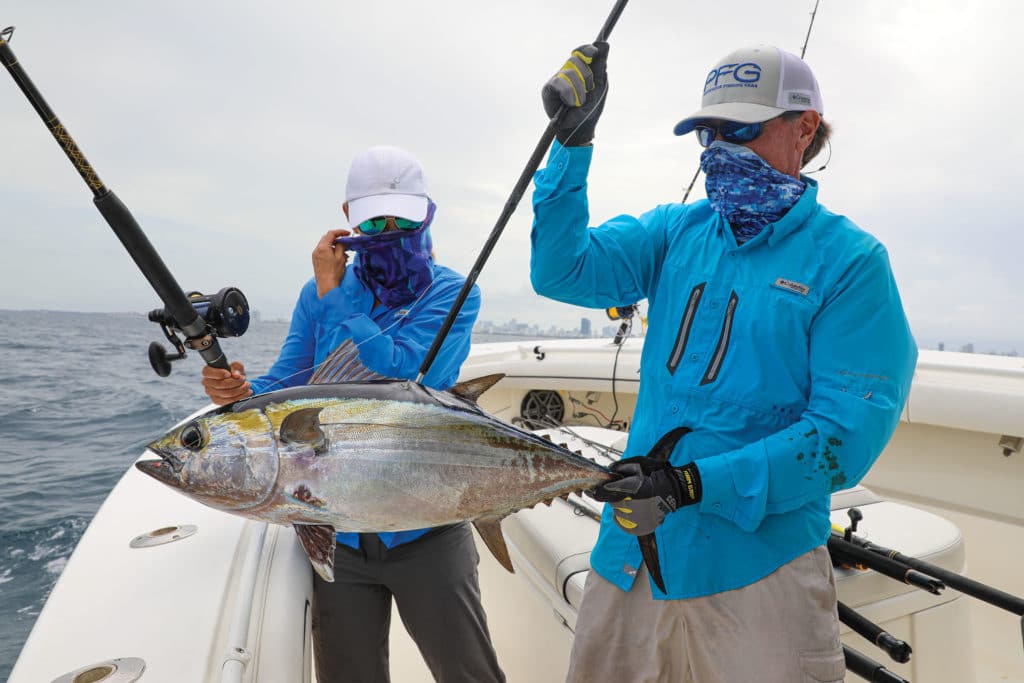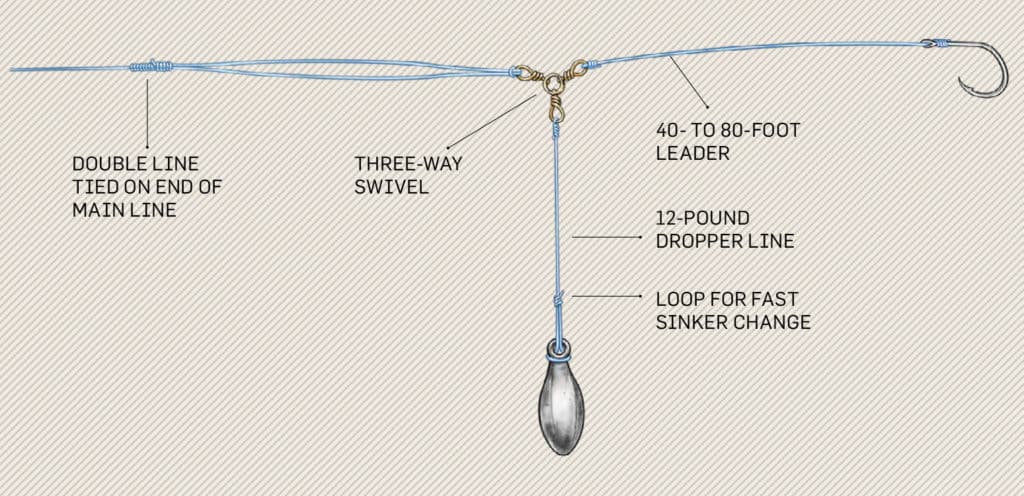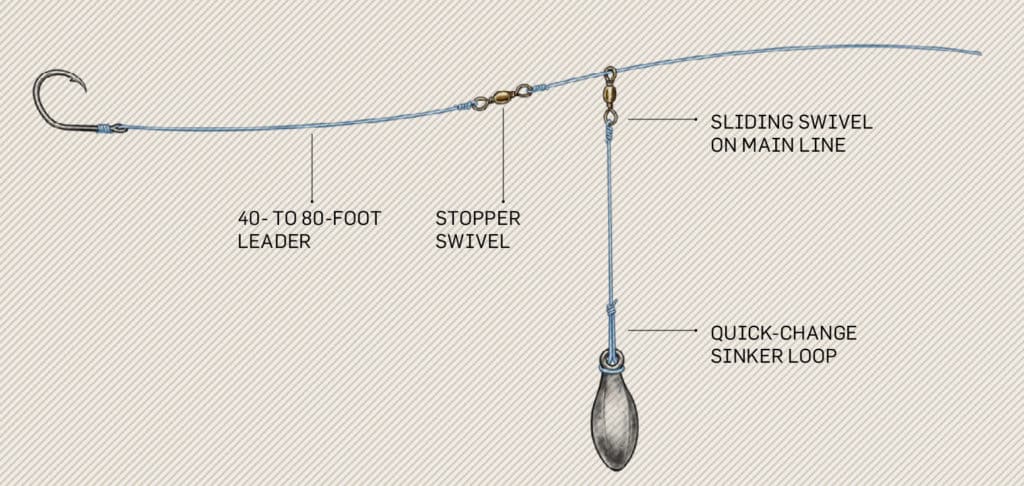
Capt. Kevin Jeffries and I settled into a drift across a deep reef off Key Largo, Florida. Having boxed our share of blackfin tuna and rainbow runners over a wreck in 225 feet, our goal was to add a mutton snapper or two to the mix. Our wishes were fulfilled promptly.
Drifting a live ballyhoo near bottom, I felt a slight tap, a pause, another tap, and a longer pause. “Must be small fish picking away at the bait,” I quipped to Jeffries. Seconds later, a thump pulled my rod into an arc. Something big and powerful peeled off 20-pound braid, a tough skirmish lasting up through most of the water column. The sinker coming into view signified the end of the fight. Or did it?
As Jeffries began hand-lining in 40 feet of leader, the mutton spiraled toward the surface. I feared it falling prey to a shark, but we finally managed to boat the trophy snapper.
Reflecting back on the subtle taps, when that mutton pecked my bait, the excessive slack in the long leader kept the fish from sensing resistance and convinced it to consume the ballyhoo.
Long Odds
Earning strikes from leery fish hinges on downsizing line class, leader and hooks, and even tweaking bait presentations. Equally important is leader length. An extraordinarily long leader, while inconvenient, presents a natural feel to suspicious fish. Grouper are less sensitive, but mutton and mangrove snappers, cobia, blackfin and yellowfin tunas, African pompano and others are more cautious.
At one time, 15 feet of leader was considered excessive. Today, for mutton snapper in particular, leaders between 40 and 80 feet are the norm. When muttons aren’t aggressively feeding, they’ll push, peck and tug at a bait. If they sense the slightest resistance, they’re gone. The slack in a long leader prevents a fish from feeling the weight some 40 to 80 feet away from the bait.

Beat the System
To maximize the potential of an ultra-long leader, scale down its strength and hook size. Case in point: For muttons, cobia, African pompano and even blackfins, for example, 30-pound fluorocarbon leaders and small hooks are a winning combination—most of the time. However, it’s sometimes necessary to drop to 20-pound leaders. And therein lies a big dilemma: When you scale down leaders for more bites, you stand a greater risk of fish fraying through them.
To greatly reduce the latter risk, use inline circle hooks. When set properly, the eye of an inline circle hook remains outside a fish’s jaw. Therefore, the leader isn’t exposed to its teeth. By comparison, small J-style hooks are often swallowed, leaving leaders to seesaw across teeth. The abrasion-resistant properties of fluorocarbon also warrant the upgrade over monofilament leaders.

For smaller snapper such as mangroves, I’ll use a 1/0 circle hook. For live-baiting blackfins, it’s a 2/0 circle, and for larger snapper, cobia and other reef denizens, I go with a 3/0 or 4/0 circle hook.
The Long Haulers
A standard, long-leader bottom rig is built on a three-way swivel. Tie the doubled fishing line to one eye, and a 40- to 80-foot leader—with the hook on the end—to the second eye. A short loop of light mono (12-pound-test) is tied to the third eye and ends in a loop that allows quickly swapping out sinkers.
Capt. Jimmy Gagliardini does a ton of spin-fishing for big muttons and other bottom dwellers using 20-pound mono. His simple leader system: A small barrel swivel rides on the fishing line, with a larger barrel swivel joining the main line to a 30-foot leader and hook. A light mono loop on the sliding swivel carries the sinker. This allows the leader some free play, further eliminating resistance.
Deep Cycles
Ultra-long leaders also perform well when deep-drifting for tuna, dolphin and billfish. We drift live baits, fresh squid and the occasional swimming plug deep for blackfin tuna on the reefs and humps off South Florida and the Keys. A 40-foot, 30-pound fluoro leader with a 10- to 16-ounce sinker positioned as many feet away from the bait provides swimming latitude for a live bait in slow to moderate currents, and for squid and trolling plugs in a fast drift (2 to 4 knots). Long, light leaders and deep baits score blackfins even during the middle of the day, when not feeding.

To rig for deep-drifting blackfin tuna off Marathon, Florida, Capt. Ariel Medero ties a short double line on a conventional outfit carrying 20-pound mono, then ties 40 feet of 30-pound fluoro leader to the double line. He clips off the last 3 feet of leader, rejoins it with a small barrel swivel to prevent line twist, and adds a small hook such as a VMC 3X-strong, 2/0 inline circle.
The weight portion of this rig is unique. Tie 2 feet of 12-pound mono to a small snap swivel, with a loop knot at the other end, to accommodate the quick sinker. Deploy the bait to the double line, then hang the open snap swivel on one leg of the double line, and leave the snap open at all times. To land a fish, reel up to the sinker, lift it off, and continue reeling in the leader.
To manage long leaders, I rig them in advance of a trip, and secure them with a Luna Sea Leader Mate, a plastic device that slips on to the rod for storage.
Gagliardini manages his leaders by winding them around their reel seat and rod guide, and reeling until taut.
To deploy a long leader, unfurl it on the water, attach the bait to the hook, and then sling the bait out as far as you can. Once the leader lies out straight, lower it, occasionally pausing to keep it from tangling on the main line.
Consider how ultra-long leaders might improve your odds of scoring more, or getting that one strike that just might save the day. Think outside the box. The one thing a long leader isn’t is a long shot; it boasts a well-documented payout ratio.
Extra-Length Leader Tips
- Strategy: As much as possible, eliminate any gear that tips off fish to your presence.
- Stealth: Keep your distance and minimize disturbance and noise in your presentation.
- Balance: Maintain just enough strength in your terminal tackle to handle fish efficiently.









